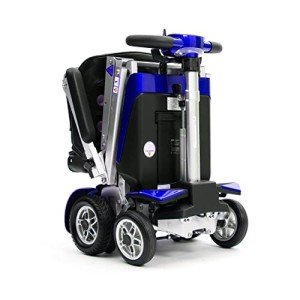20 Questions You Should To Ask About Mobility Scooter Prior To Purchasing Mobility Scooter

A Comprehensive Guide to Buying a Mobility Scooter
Mobility scooters have become an essential tool for lots of individuals seeking to enhance their independence and mobility. With a huge selection of designs and functions offered, choosing the best mobility scooter can be daunting. This post offers a useful guide to assist customers navigate their alternatives, examine their needs, and make a notified purchase.
Comprehending Mobility Scooters
Mobility scooters are electric lorries designed for individuals who experience mobility difficulties. their website are particularly helpful for elders, those with impairments, or individuals recuperating from injuries. Mobility scooters can differ extensively in terms of style, functions, and rates.
Types of Mobility Scooters
Before embarking on a purchase, it's necessary to comprehend the different kinds of mobility scooters readily available:
Three-Wheel Scooters:
- Generally more maneuverable in tight areas
- Lightweight and portable
- Ideal for indoor usage
Four-Wheel Scooters:
- Offer greater stability and balance
- Ideal for outside use over different surfaces
- Generally have a longer battery life
Foldable/Portable Scooters:
- Designed to be easily transferred and stored
- Can typically fit in the trunk of a cars and truck
- Suitable for those who take a trip frequently
Sturdy Scooters:
- Built to accommodate bigger people
- Frequently come with more robust features for outdoor use
- Usually equipped with larger batteries for prolonged range
Elements to Consider When Buying a Mobility Scooter
1. Weight Capacity
Pick a mobility scooter that can support the user's weight. Most scooters have a weight limit varying from 250 to 500 pounds. It is important to ensure that the scooter can accommodate the user conveniently.
2. Variety and Battery Life
The variety is how far the mobility scooter can take a trip on a single charge. Typical varieties vary in between 10 to 30 miles. Think about the user's day-to-day activities and choose a scooter with an appropriate variety.
3. Scooter Dimensions
Think about the size of the scooter, including its weight and measurements. A more compact scooter might be perfect for narrow corridors and tight spaces, while bigger designs use extra stability and comfort.
4. Surface Capability
Examine where the scooter will primarily be utilized. If the user prepares to travel primarily on pavement, a lightweight design might be adequate. Nevertheless, if the user requires to pass through gravel or unequal surfaces, think about a four-wheel scooter developed for off-road use.
Top Features to Look For
Comfort
- Adjustable Seats: Look for scooters with cushioned and height-adjustable seats to ensure convenience during travel.
- Armrests: These enhance safety and support while navigating.
Security and Visibility
- Headlights and Taillights: Essential for nighttime usage.
- Turn Signals and Reflectors: Improve exposure and safety while on the road.
User-Friendly Controls
- Joystick or Drive Controls: These should be instinctive and easy to control.
- Easy-to-Read Displays: A control board that shows battery life, speed, and range can enhance the user experience.
Extra Features
- Storage Compartments: These use included convenience for carrying personal products while on the go.
- Weather condition Protection: Consider designs with rain covers or windscreens if utilized in variable weather conditions.
Cost Considerations
When budgeting for a mobility scooter, prices can range anywhere from ₤ 500 to over ₤ 5,000 depending on the model, features, and brand name. Additional expenses may consist of:
- Extended Warranty: Protects versus flaws and can conserve money in the long run.
- Accessories: Optional functions, such as upgraded seats, lights, or storage solutions.
| Feature | Expense Range |
|---|---|
| Basic Models | ₤ 500 - ₤ 1,500 |
| Mid-Range Models | ₤ 1,500 - ₤ 3,000 |
| High-End Models | ₤ 3,000 - ₤ 5,000 |
Financing Options
Numerous sellers offer financing plans, and some city government efforts might provide grants or assistance for those in requirement. Examine potential financial help with neighborhood resources or mobility service companies.
Frequently asked questions about Buying a Mobility Scooter
What is the distinction in between a mobility scooter and a wheelchair?
Mobility scooters are motorized and enable users to navigate individually, while wheelchairs may require physical support or manual operation.
How do I preserve a mobility scooter?
Regular upkeep includes examining battery life, cleaning up the scooter, and checking tires and brakes. Always refer to the user handbook for particular standards.
Can mobility scooters be utilized inside?
Yes, many designs are designed for both indoor and outdoor use. Nevertheless, three-wheel scooters tend to be much better matched for indoor navigation due to their tighter turning radius.
Are mobility scooters covered by insurance coverage?
Some insurance coverage plans cover a part of the costs for mobility scooters if they are deemed clinically required. Contact your service provider for specific details.
How quickly can a mobility scooter go?
The majority of mobility scooters have an optimal speed varying from 4 to 8 miles per hour. However, the suitable speed may vary depending on local regulations.
Buying a mobility scooter can significantly improve one's independence and quality of life. By understanding the types, features, and expenses related to mobility scooters, prospective purchasers can make well-informed choices that fit their needs and choices. Personalization and comprehensive research are crucial to guaranteeing complete satisfaction with this essential financial investment.

